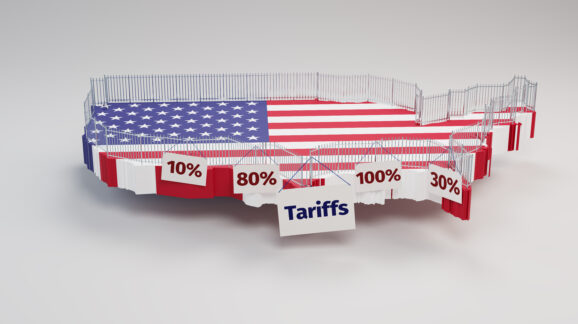Trump tariffs result in price increases and slashed forecasts

Photo Credit: Getty
When politicians talk tough on trade, it’s often American businesses and their customers who pay the price. Behind the headlines about economic nationalism and “bringing jobs home” lies a quieter but more painful truth: tariffs are hidden taxes that force domestic companies into difficult choices. Whether it’s a retailer trying to stay competitive or an automaker struggling to maintain price points, tariffs disrupt efficient business models and ripple through the economy in the form of higher prices and tighter margins.
Tariffs, at their core, are taxes on imports. This means that companies who import goods from foreign countries face higher costs to run their businesses. These costs, especially for companies in low-margin industries, present substantial logistical and operational challenges. Instead of running their businesses in the most efficient and optimal manner, companies must either pay the duties or evade higher import prices by shifting operations strategies. Either way, they are forced to resort to suboptimal business strategies, often resulting in worse or more expensive products.
President Trump’s tariff frenzy has resulted in massive uncertainty for many businesses who rely heavily on imported goods. Many of these companies have been forced to raise their prices to an artificially high level. Sectors that have been hit the hardest include retail stores, fashion brands, and automobile manufacturers, whose business models are based on imported materials and products.
CNET’s Thomas Kika found 13 cases in which companies were forced to hike their prices because of tariffs. Among these companies is Best Buy, which, according to CEO Corie Barry, “has increased prices on some products to offset tariff-related cost increases… [and] has worked to offset the impact by negotiating with its suppliers to reduce costs, adjusting the products it sells and expanding the number of countries from which it imports goods.”
Macy’s CEO Tony Spring also said that it will implement price hikes on specific products due to tariffs. As of Monday, Macy’s stock is down over 30 percent year to date, and the department store reduced its expected adjusted earnings per share from $2.05 to $2.25, to $1.60 to $2.25. According to CNBC, about 15 to 40 cents per share of the guidance cut is a direct result of tariff policy and that “about 20% of the company’s merchandise comes from China.” This also shows that American investors are paying a tariff price in reduced earnings.
Automakers like Volvo, Toyota, and Subaru have also been negatively affected by tariffs. At the end of May, Yahoo Autos reported that, because of tariffs, Volvo’s CEO said that selling “the automaker’s Belgium-made EX30 stateside for the original $34,950 price tag would be ‘almost impossible’ at this point.” Instead, the EX30 would be priced at $46,195, a roughly 32 percent increase. According to Yahoo Autos, that number “appears to be Volvo hedging a bet that a 25 percent tariff is more likely than a 50 percent tariff, and that it will protect its profit margin if the tariffs are implemented.” Similarly, Subaru has raised prices on almost all of its vehicles, with price increases ranging from $750 to $2,055. Toyota also planned to raise prices. According to Bloomberg, “some Toyota- and Lexus-branded models will see their prices raised by an average of $270 and $208,” following in the footsteps of Mitsubishi Motors, who raised prices mid-June.
The far-reaching effects of tariffs on consumer prices may come as a surprise to some, given that the May Consumer Price Index rose at a lower rate than most economists expected. Labeling tariff-induced price rises as ‘inflationary’ would be incorrect, because tariffs result in price hikes for specific goods within specific markets, rather than comprehensive price increases across the entire economy. True inflation is caused by an increase in the money supply relative to the amount of goods and services provided. Since tariffs affect prices on goods, but don’t change the overall money supply, they are not technically inflationary.
With that being said, it would be a mistake to assume that, because inflation seems to be relatively cool, tariffs have not had harmful effects on the economy. It is far more useful to look at specific examples of companies who have had to raise prices or adjust operations strategies to truly understand the magnitude of impact that tariffs have had. Lastly, it is important to keep in mind the countless small businesses ravaged by tariffs, and who may not have the same flexibility and cushion that larger corporations have.
Tariffs may seem like a blunt instrument aimed at foreign competitors, but their real costs land squarely on American companies and consumers. From department stores to car manufacturers, businesses across industries are raising prices, cutting forecasts, and scrambling to adapt to policies that upend the principles of efficiency and free enterprise. While overall inflation may appear muted, the damage done by tariffs is deep, targeted, and persistent—especially for small businesses without the resources to absorb the blow. In the end, the costs of these policies are not paid in abstract political wins, but in real dollars at checkout.